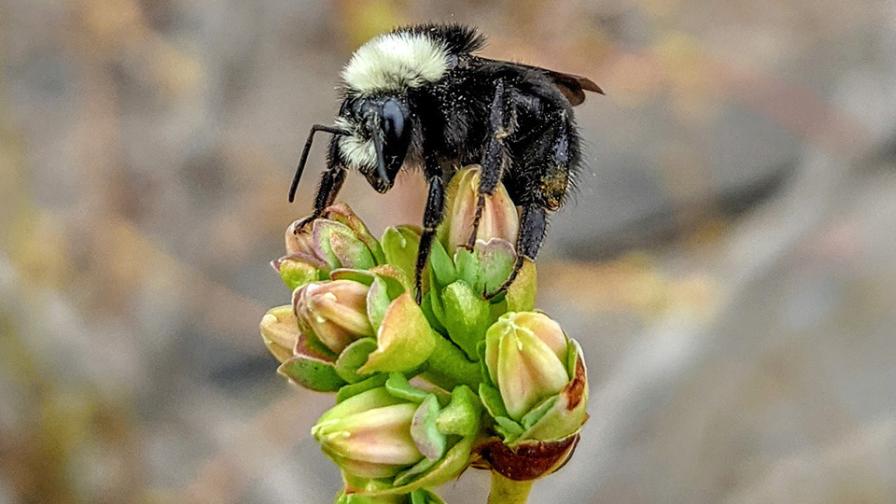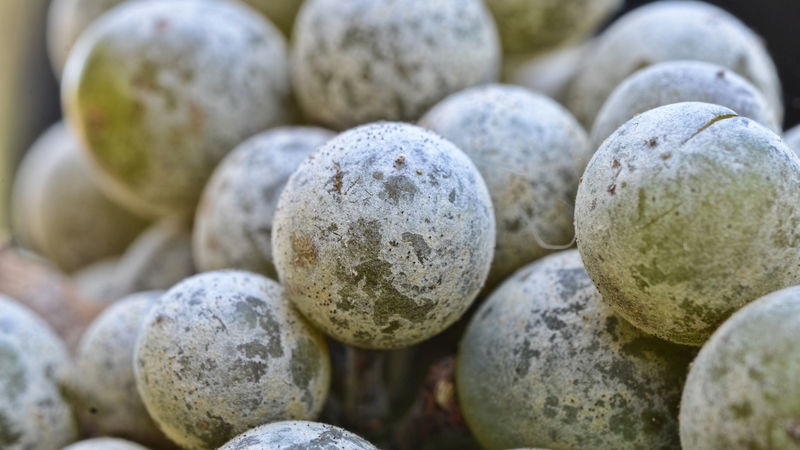The Promise and Pitfalls of Using Managed Bumblebees for Blueberry Pollination

This managed yellow-faced bumblebee (Bombus vosnesenskii) is on a pollination mission as it works on unopened blueberry blossoms.
Photo by Lisa DeVetter
Ensuring sufficient pollination is a challenge shared by many blueberry growers. While honeybees can get the job done, optimal foraging conditions may not coincide with the bloom time of many cultivars. That is why yields are smaller when weather conditions during bloom are not optimal — honeybees tend to forage less when it is overcast, cold, and/or windy. Additionally, honeybees are morphologically not well adapted to pollinate blueberry.
These challenges have caused growers and researchers to look for alternative techniques to safeguard pollination.
Bumblebees are excellent pollinators of blueberries. Not only do they forage from early morning until late at night and under cooler and suboptimal weather conditions compared to honeybees, but they are also more efficient. This is because bumblebees can buzz pollinate (or sonicate), which occurs when a bee vibrates her flight muscles, thereby stimulating pollen release. Buzz pollination is required for bees to collect pollen in an effective way from blueberry where access to pollen is difficult compared to other pollination-dependent crops. Honeybees cannot buzz pollinate, leading to less pollen on honeybee bodies to transfer to other blossoms for pollination.
MANAGING BUMBLEBEES
For blueberry growers to reap the benefits of bumblebees, they will have to rely on native populations or use managed colonies.
Managed bumblebees are raised in laboratories and sold to provide pollination services for a few weeks. Use of managed bumblebees to provide or enhance crop pollination is not new. Growers around the world have been using commercially raised buff-tailed (Bombus terrestris) and common Eastern (B. impatiens) bumblebees for years. The Western bumblebee (B. occidentalis) was also deployed in the 1990s in the Western U.S., but a disease outbreak decimated managed colonies, led to severe declines in native bumblebee populations, and this species is now unavailable to U.S. growers. Western growers consequently had no managed bumblebee species. However, this has now changed.
Yellow-faced bumblebees (B. vosnesenskii or B. vos) are now available for pollination in open fields in the Western U.S. A bonus — B. vos is native to Western U.S. As researchers working on crop pollination and recognizing the benefits of native pollinators like bumblebees, the arrival of B. vos should be welcomed news, right?
While use of managed bumblebees is alluring, caution is warranted, and further research is required. Why the caution?
Pathogen spillover is the biggest concern. Managed bumblebees often contain higher pathogen loads, which they can transmit to other species. Pathogens are deposited on flowers by visiting bumblebees and subsequently transmitted to other species that visit the same flowers. The increase in pathogen load and possible introduction of new pathogens threatens the health of wild bumblebees already struggling or at risk.
Another mechanism whereby managed bumblebees can affect the wellbeing of native populations is through competition for floral resources before and after blueberry bloom. Over time, densities of managed bumblebees can increase. These expanding colonies can rapidly gather large amounts of nectar and pollen, leading to local resource depletion for native pollinators.
Both pathogen spillover and resource competition impact other pollinators, including solitary bees and honeybees.

Blueberries have an urn-shaped blossom that bumblebees are adapted to pollinate, while honeybees struggle.
Photo by Lisa DeVetter
STATE-LEVEL RESPONSIBILITY
While USDA controls movement of bees between countries, it is up to individual states to regulate their movement within and between states. This has led to variable and inconsistent rules and enforcement, putting the burden on companies, growers, and crop advisors of responsible use of managed pollinators like bumblebees.
What to do if you have used managed bumblebees on your farm? Despite being sold and advertised as “native,” used quads should be destroyed (i.e., burned or frozen) after bloom to limit their potential negative consequences. After crop bloom, B. vos transitions to foraging in native habitats, gardens, and elsewhere, where flower density is lower and therefore the likelihood of spreading pathogens to other species increases. Do not release managed bumblebees into the wild or rely on queen excluders — queens may pass through excluders. Previous experience with the Western bumblebee is an important cautionary tale of the potential negative effects of managed bumblebees.
Furthermore, support research efforts! While several growers we interact with expressed dissatisfaction with their first experience with managed B. vos, the potential of bumblebees is real. However, successfully integrating them into a viable on-farm pollination system requires research that identifies the promises and mitigates pitfalls associated with using these promising pollinators.









